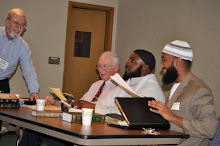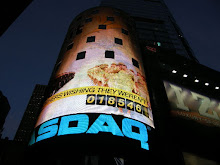By Leslie Berestein,
UNION-TRIBUNE STAFF WRITER
Friday, December 25, 2009
Nelvin C. Cepeda / Union-Tribune
Striking cabdrivers protested yesterday near City Hall, later marching down Broadway to the Hall of Justice and Horton Plaza.
Striking cabdrivers protested yesterday near City Hall, later marching down Broadway to the Hall of Justice and Horton Plaza.
A few days after about 300 San Diego taxi drivers went on strike to protest the amount of money they pay to lease cabs, organizers gathered the drivers in a City Heights meeting hall to rally them. The impassioned speeches were in Somali.
In San Diego, Somali immigrants are nearly synonymous with the taxicab industry. Since Somalis began settling here in large numbers as refugees in the early 1990s, fleeing a civil war at home, they have come to dominate the business as drivers. While there is no official figure, it is estimated by groups who work with African immigrants and by drivers themselves that at least three-fourths of San Diego cabbies are East African, the vast majority from Somalia. Others are from Ethiopia and Eritrea, and a few are from other African countries.
“It is the easiest thing to do when you come from another country, and you know how to drive,” said Hakeem Kalif, 40, who arrived from Somalia in 1992 and began driving a taxi four years later. “You only need a Thomas Guide.”
The cabbies follow in a long-established tradition, the immigrant social hiring network, an informal system of referrals and recruiting that has existed for as long as immigrants have been landing on these shores.
Just as social networks help determine where new arrivals to the United States settle, they also help determine the jobs they get, with established immigrants helping arriving family members and friends find work.
The end result is one ethnic group heavily represented in a particular industry: for example, Mexican immigrants in construction, Iraqi Chaldean immigrants operating liquor and convenience stores, Korean immigrants operating small grocery stores, Vietnamese immigrants in the nail-salon industry.
“A brings in B, B brings in C, and C brings in D until finally, you’ve got A through Z,” said Ivan Light, a professor emeritus of sociology at UCLA and co-author of “Ethnic Economies,” a book that examines ethnic-dominated industries. “You don’t own the business, but you control access to it, and it becomes a valuable economic resource for the community in the sense that you get to certain point, and you control access to the jobs.”
The same can happen in a corporate environment, Light said, recalling a tour of a Los Angeles bank several years ago during which the manager pointed out to him that on one floor, most of the workers were Cuban. The immigrant employees had such a strong social network that they themselves took care of finding applicants when there was a vacancy.
“As soon as one Cuban left, they recruited another,” Light said. “The bank was happy with it because the Cubans were good workers, and the Cubans were happy with it because they could find jobs.”
Driving a taxi has become a common occupation for Somali immigrants and other East Africans, not only in San Diego but also in Minneapolis-St. Paul and Washington, D.C. In San Diego, with an East African population that includes an estimated 15,000 or more Somalis, it is not unusual to see a Muslim cabbie pull over to observe a call to prayer by taking a moment to pull a small prayer rug onto the sidewalk and kneel toward Mecca.
Most of the local Somali cabbies say they were referred to the job by word-of-mouth. Ahmed Syaed, a driver and strike organizer who sits on the board of a Somali taxi drivers association, said the cabbies — who typically work 12-hour shifts, sharing a car with another driver — enjoy the flexibility the job gives them to find a few hours here and there for college or trade classes, or to study English. Many also have families.
“It is important for us to have such a flexible job,” Syaed said last weekend during a meeting at the East African Community and Cultural Center in City Heights. “Many of us are students here.”
Bob Montgomery, director of the International Rescue Committee in San Diego, said Somali immigrants entered the taxi industry soon after refugees began arriving in San Diego, following in the footsteps of earlier Ethiopian immigrants, who had also taken to driving cabs. The freedom of driving a cab works for immigrants from these largely agricultural economies, where the climate determines the workday, he said.
“Especially with East Africans, the 9-to-5 work schedule is something new to them — not to all of them, but to a lot of them,” said Montgomery, whose office helped settle the bulk of Somali refugees in the area. Immigrants from South Asia, the West Indies and Africa make up the bulk of the nation’s taxi drivers, said Bruce Schaller, deputy commissioner for planning and sustainability with the New York Department of Transportation. Five years ago, while working as a private consultant, Schaller wrote a report on the growing number of immigrants in the taxi industry.
Until the 1970s, it was much more common to see native-born U.S. citizens behind the wheel of a cab, he said. Things began to change as crime became a growing concern, Schaller said, making driving a taxi a riskier occupation than many U.S.-born workers wanted. A changing job market also meant new opportunities for younger drivers, such as temporary office work.
According to Schaller’s research, which was based on U.S. Census data, only 8 percent of the nation’s taxi and limousine drivers in 1970 were immigrants. By 2000, that had risen to 38 percent, one of the highest proportions of immigrant workers of any occupation in the country.
Some immigrant drivers see their job as a steppingstone as they study or learn English, Schaller said. Some have stayed in the industry but have gone on to buy their own taxis or even a fleet; in San Diego, for example, immigrant cabbies typically lease from immigrant cab owners, among them Russian, Middle Eastern and other African immigrants, including former drivers. There are about 1,000 taxis in San Diego.
The striking cabbies are at odds with owners affiliated with Yellow Cab over lease rates that they say are too high in comparison to their recession-battered earnings. But when the money is good, it’s not a bad job to have, Schaller said.
“Some will be driving a cab for a long time to come,” he said. “But they are very, very proud of their sons and daughters who are going to Harvard or MIT.”
Leslie Berestein: (619) 542-4579 ; leslie.berestein@uniontrib.com
Subscribe to:
Post Comments (Atom)


















































No comments:
Post a Comment